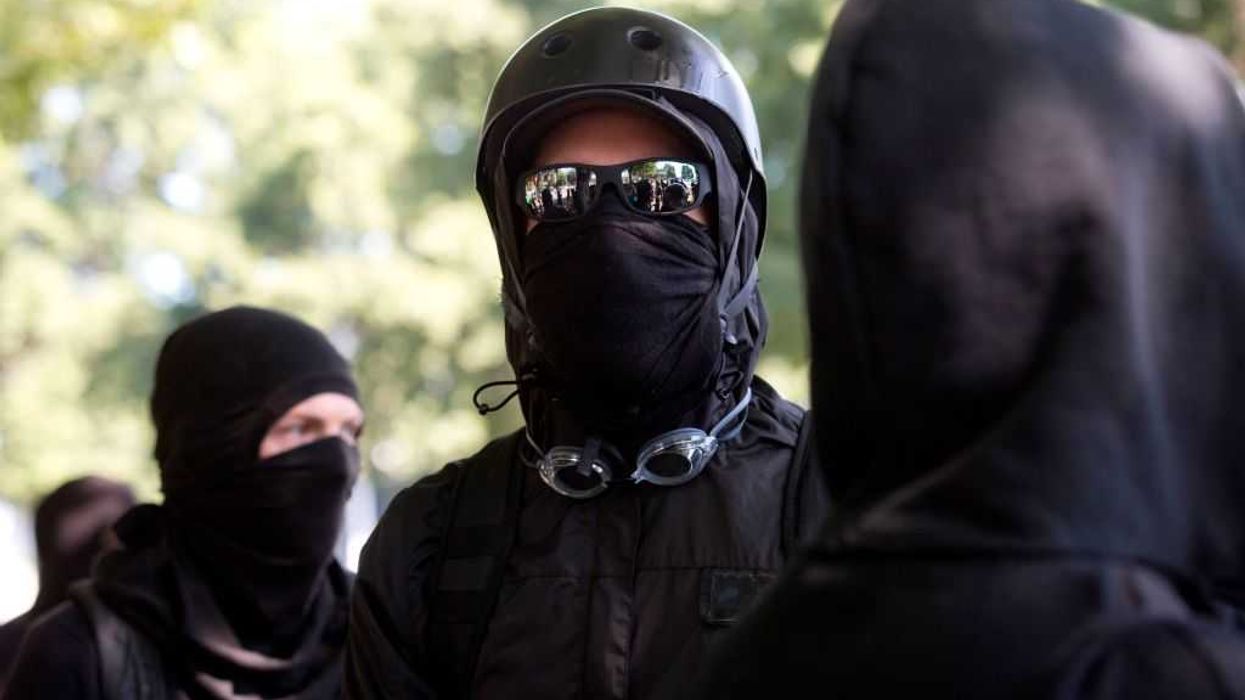Sec. John Kerry said that if America stops the Iran nuclear deal, the US dollar could no longer be the world’s reserve currency. What does that really mean? Glenn feels like something really bad is coming for the U.S. dollar and the global economy, and asked economist David Buckner to come onto the radio show and discuss.
GLENN: Just two days ago, we had John Kerry say this about the deal with Iran.
JOHN: That is a recipe very quickly, my friends, businesspeople here, for the American dollar to cease to be the reserve currency of the world, which is already bubbling out there.
GLENN: So what does that even mean? I asked an audience last night what they thought that meant, and nobody really had any idea. I have somewhat of an idea, but I don't even know if I understand it. David Buckner is here. David Buckner is adjunct professor at Columbia University. An economist who goes all over the world trying to work with businesses and trying to hold things together. And he's been a consultant on this program for quite some time. David, welcome to the program.
DAVID: Good to hear from you, Glenn. How are you doing?
GLENN: Where are you in the world today?
DAVID: I'm upstate New York in the backwoods somewhere in the mountains right now. Life is pretty good, pretty sunny.
GLENN: Okay. Sorry to bother you. We just wanted to know exactly what that meant, David. I have this feeling that something really bad has begun especially with the devaluation of the currency in China and with Secretary Kerry saying that. It's almost like a shot across our bow that they know that we're on a course for something, and they're just -- they're going to use it to blame it on something that is convenient for them.
DAVID: Well, it actually started two or three years ago when China signed its first agreement. Do you recall that the reserve currency back prior to, you know, World War II was the sterling. Was the pound sterling. And it was the Bretton Woods Act in '44 and thereon through '55 that we transitioned to the dollar. And all that really meant was that we were going to exchange the dollar for oil. So it's the currency used for the exchange of oil. This is where Secretary Kerry starts pulling in ISIS in the Middle East.
Well, two years ago, China signed an agreement with Russia to no longer use the dollar. And within 17 days, Australia signed the agreement with China as well, that they would only -- it was almost like a unilateral treatment of currencies where they would decide between the yen and the Australian dollar or the yen and the ruble and other currencies. That they would exchange without the dollar being the global entity.
So we've already started down this path. What he identifies there is a little bit frightening because he's indicating that we have to make a decision, aligned with the current policy with ISIS, Iran, and others, or we're going to be -- we're going to lose the dollar. We're already on that path. And quite candidly, we're being held hostage by suggesting we have to capitulate or the dollar is going to be gone.
The dollar is already being comprised. And the question you asked regarding China is evidence of that. The fact that China has so much of our debt and that we're beholden to any movement they make in their currency indicates that any time they do something, like they did yesterday -- they did a 5 percent shift in their currency.
Their currency has been selling about 6.1 or 6.2 yen to the dollar. They moved up to 6.4, 6.5. There's a shift that immediately does two things to us: One, is makes their goods 5 percent cheaper. So that means our goods become expensive compared to them. That means more people are going to buy directly. Which, by the way, puts them in a better position to negotiate more of those deals to get rid of the dollar. That's one thing.
The second thing it does that nobody is talking about, that's more frightening for me personally, from a macroeconomic perspective, and what you and I have been talking about, Glenn, for probably three years now. And that is that what we owe China, all of that debt, we're talking trillions of dollars of debt, the largest percentage to China and a big chunk in Japan. What we owe them now has become 5 percent more expensive overnight.
Now, it doesn't mean the interest rates have changed, but the money that we borrowed -- and borrowed it when it was worth six, we now have to repay that same amount of money that if we were to use it to buy goods would be worth more. But we can't.
So we lose 5 percent on every dollar we're returning to them. That is an overnight shift in interest rates, if you will. Even though the interest hasn't changed, the buying ability of that piece of paper. So we're in a position where overnight, China made our commitment to them 5 percent more expensive. And made all of their goods 5 percent cheaper. So we're fighting -- we're fighting this -- this is crazy, Glenn.
GLENN: So tell me, David, what it means -- explain to somebody -- because what Secretary Kerry was saying, not getting off the dollar as the exchange rate for oil. But he's saying the reserve currency, which means people are not -- they're not generally having a bunch of gold in their bank. What they have is a bunch of US dollars. And if everybody gets rid of the reserve currency and goes off that, all those dollars come flooding back into the system. Am I wrong?
DAVID: No, you're correct on that. And the reason -- and you're correct. Let me blend the two words though, that we're aligned in this.
You're correct when we're talking reserve currency. That is because it is -- it has always been the global currency.
GLENN: Correct.
DAVID: So when we no longer -- the reason I linked in the oil is not because it's changing anything there or anybody has agreed differently. But the reality is, if there's other ways to purchase oil, we no longer need a large reserve, if I'm a foreign country, of US dollars.
GLENN: Correct.
DAVID: Consequently, I can then --
GLENN: Hang on just a second. So people understand that. That's because you were only allowed to buy oil in US dollars. So countries had to have that huge cash of the US dollar because if you wanted to buy something like oil, you had to buy it in dollars. That's quickly going away.
DAVID: Exactly.
GLENN: So how much money is in the -- the central banks of countries? How much -- how many dollars are there?
DAVID: Okay. Now, that's a question without my precise answer for this reason.
What we know we have put out there into a secondary market. You know, when we're shoving dollars out. When the fed shoves money out by buying bonds, that money goes out. And while we can say it's traceable, it's not traced. In other words, what goes out into the U.S. in a bond may make its way by others buying from China, from India, from other places.
So when we're talking about central banks holding them, they'll have what you might call an official number. But the unofficial market is unwieldily. So we know how much is out there. And that we've been flooding. That's been the damaging and frightening part of this, Glenn, is that we keep shoving it out there. And if it gets aggregated into one place, if China starts reserving it and holding it, then they have a huge club. And we keep saying, no, surely, surely they wouldn't have it. We've diffused it. The money is going out broadly. But nobody can track where it's actually being collected and held because the public announcement -- just like China has indicated that they devaluated their own currency, but they control their banking. So when you go to China -- you know I spend a lot of time there.
GLENN: Yes.
DAVID: And when you go to China, you have a variety of different ways in which currencies can be exchanged. When you go to Brazil, there are three totally different currencies: The dollar at the bank, the dollar on the street, and the dollar you pay in a hotel, which is the government rate. And they are vastly differing numbers.
So I'm not wobbling other than to suggest that I can -- I could give you formalized numbers. We could go back and look those up. They're irrelevant. The money that's out there could be aggregated by these central banks, and we do not know which central bank is truthfully aggregating the largest in their formal and informal economy.
GLENN: So here's what I really want to know, and I'm hoping that you're going to say I'm wrong. But this to me, when I heard this, what I heard was the equivalent economically of him saying, by the way, if you disagree, it is total nuclear war. This is an economic -- if the dollars that other countries have are no longer being used as the global currency and the world's reserve. That means that all those dollars are out and we're in hyperinflation and it is -- it's the end of the West or the western commerce as we know it. At least for -- at least until we can settle on what we're doing.
DAVID: Right. There are three things -- we talked about this before. But there are three things that America offers right now. One is that we offer the dollar. Okay? And if that goes away, that's frightening, right?
GLENN: Wait. Wait. Wait. Explain why -- tell people what that means, if the dollar goes away, to them.
DAVID: Well, right now because every exchange is principal for oil, which is the central currency of everything. Energy is everything, okay. Because that exchange must go through us and we control the medium or the piece of paper that you can use to exchange, we control -- I don't want to say control the world. But we control that exchange. And if that's the central exchange, then we still have some significant control on the markets of the world. If that is removed, you no longer have control. If you go into, you know, Germany and you're not using euros and you're using a Brazilian currency that nobody cares whether you have or not, you don't buy anything in Germany. So if our dollar is no longer viewed as the global necessity, we don't have that to offer.
GLENN: So hang on. Before you go on, on that. So, in other words, we become like Iceland. What was it, the kronas, that when it crashed and went away. They couldn't buy meat for McDonald's. Everything had to shut down. We wouldn't be able to buy oil from anybody because no one would accept the US dollar because it would be worthless.
DAVID: It's an irrelevant piece of paper. Most people would say that because there's so much debt being held of US debt, we're betting on our bankers not letting us fail. Now, that scares me, just to be honest. I don't want to bet on my bank not wanting me to fail especially if my house goes up in value and they'd rather take the house rather than to default on what I owe them. Okay? Our house is our natural resource in the U.S. So if we default and we have collateralized our -- the assets of our country, which are our natural resource. Then technically, just like they did in the 1980s when Manhattan, a good percentage of the real estate had to go to foreign entities. We hit such a downside, that you would see Chinese and Japanese signs in front of banks because the real estate was owned by them. We've collateralized what America has against our debt. And our debt is in crazy land. You know that. We've talked about that before.
GLENN: Right.
DAVID: So if the dollar goes away and they go technically after the assets and we then defend the assets, then you are correct that the next thing we offer is war. And that's not where -- and, by the way, I'll give you just one side note that may be contrary to what you think or it may be differing than what you think or it may simply augment it. I actually think the next real battle issue will not be metal against building. I think we can do more with cyber and banking zeros. Ones and zeros in the electric world than we can ever do with weapons.
GLENN: Yes, I agree.
DAVID: I think the next war will be a cyber disaster. And the frightening thing about that is, if you are the one that owes the rest of the world, they have control over your assets. It doesn't take much for them to be able to access all of those buttons. And that's where it gets crazy. So, Glenn --
GLENN: Go ahead. Wrap it up here, David.
DAVID: I was in Hiroshima a week ago. I was there for the 70th anniversary for the disaster there. And they talk about one bomb. And we talk about 15,000 warheads that exist if the world. All it takes is one finger to push buttons to get things crazy. And one one and one zero in the banking world or the economic world to get people desperate. I don't know when we get to that point. But I will tell you, this move by China to shift things by 5 percent in 15 minutes is a daunting look at where we go and what America has to see in the economic future.
GLENN: Thank you a lot, David. I appreciate it. Go back to the mountain and enjoy the sunshine.
DAVID: Good talking to you.
GLENN: God bless you. David Buckner.

 Hesham Elsherif / Stringer | Getty Images
Hesham Elsherif / Stringer | Getty Images
 Julia Beverly / Contributor | Getty Images
Julia Beverly / Contributor | Getty Images PEDRO MATTEY / Contributor | Getty Images
PEDRO MATTEY / Contributor | Getty Images AFP Contributor / Contributor | Getty Images
AFP Contributor / Contributor | Getty Images